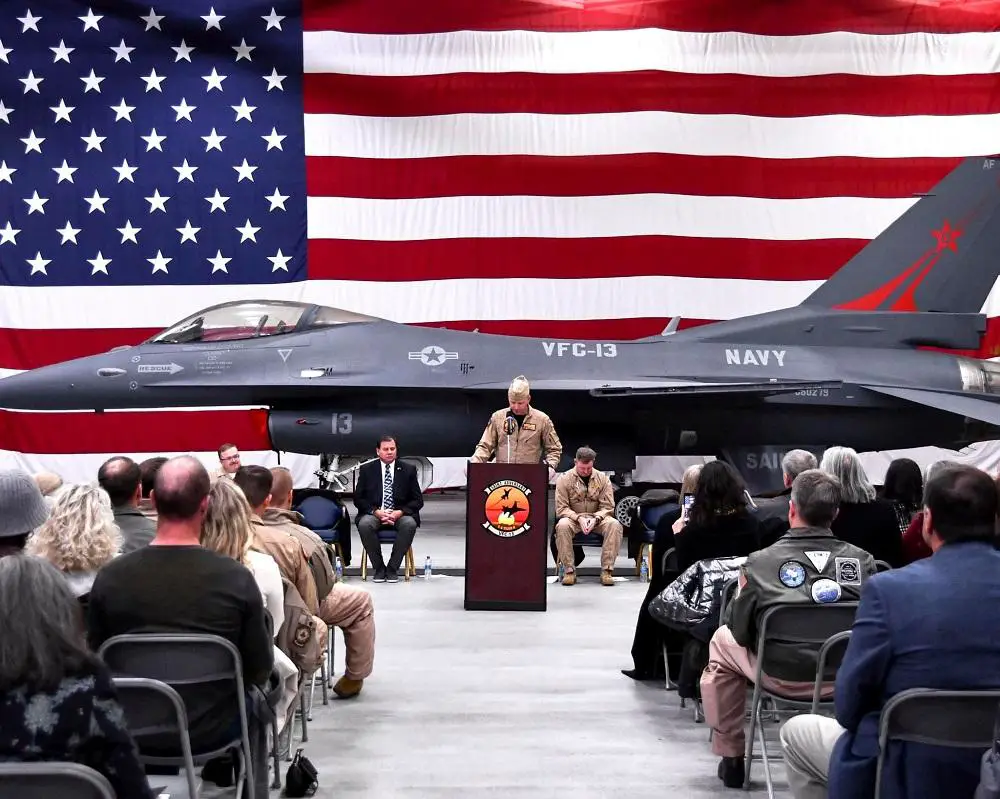The U.S. Navy Fighter Squadron Composite (VFC-13) Fighting Saints also celebrated the squadron milestone of transitioning from the Northrop F-5N Tiger II aircrafts (which the squadron has operated since 1996) to General Dynamics F-16C Block 32 Fighting Falcon aircrafts. VFC-13 will operate twelve F-16C Block 32 fighters and the unit’s F-5N Tiger IIs will primarily be used to re-equip Fleet Composite Squadron (VFC) 204 River Rattlers (‘AF-4xx’) at Naval Air Station / Joint Reserve Base New Orleans (LA). The “Fighting Saints” also conducted an airborne Change of Command, with CDR Dick Burns being relieved by CDR Austin Coovert. The airborne ceremony was followed by a retirement ceremony for CDR Burns in Hangar Four aboard NAS Fallon.
The Hornets are the last in US Navy service and are becoming very expensive to operate, the cost per flight hour is some USD 44,000. In order to increase the number of adversary aircraft, the US Navy purchased a further eleven F-5E/F aircraft from Switzerland in fiscal 2020. The additional Tigers will be modified with modern avionics and an airframe reconfiguration to match the current active US Navy airframe configuration. The current fleet of 31 Tigers is assigned to Fighter Squadron Composite (VFC) 13 Saints at NAS Fallon (NV) and VFC-111 Sundowners at Key West, Florida. The U.S. Navy Reserve Tactical Support Wing (TSW) is using F-5N/F Tiger IIs and F/A-18A/C/D Hornets to support adversary missions for the US Navy active fleet.

Scramble Magazine reported that the US Navy was once an operator of the F-16N; 26 F-16Ns and 4 TF-16Ns were ordered in 1985 to fulfil its Dissimilar Air Combat Training (DACT) mission. First deliveries of these modified (stripped to save weight) aircraft started in June 1987, with final deliveries in February 1988. The U.S. Navy purchased fourteen other F-16s: ten F-16As and four F-16Bs, all Block 15s. These Fighting Falcons were all embargoed Pakistani aircraft that were brand-new, straight from the Lockheed Martin production line and stored at the 309th AMARG. The fourteen aircraft were delivered from late 2002, and all were assigned to the Naval Strike Air Warfare Center (NSAWC) at Fallon. That unit was redesignated into Naval Air Warfare Development Center in 2015.
Fighter Squadron Composite (VFC-13) Fighting Saints is a US Navy fighter squadron that provides adversary training for U.S. Navy air wings at NAS Fallon, Nevada. VFC-13 uses “Bogey” as its main radio callsign. VFC-13 provides adversary training for Navy and Marine Corps Active and Reserve fleet and replacement squadrons, carrier air wings and Marine aircraft groups. The squadron has received two consecutive CNO Safety Awards, the Golden Wrench Maintenance Award, and in 1994 and 2011, the Battle “E” award. In April 2022, plans to replace VFC-13’s F-5s with Block 32 F-16 Fighting Falcons which are being retired from USAF service became public. The squadron’s F-5s will be transferred to VFA-204, a US Navy adversary squadron currently operating F/A-18 Hornets. VFA-204, based at Naval Air Station Joint Reserve Base New Orleans, is scheduled to retire its aging fleet of Hornets and will be redesignated VFC-204 by October 2022.













